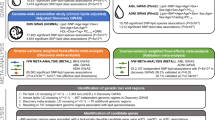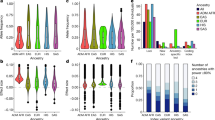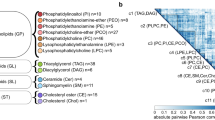Abstract
The search for common genetic determinants of plasma lipoproteins began in the early 1980s. Despite some exceptions, these efforts have not yet yielded a set of biological markers that can be used in clinical practice. By contrast, successes in defining the molecular basis of rare single-gene disorders, such as familial hypoalphalipoproteinemia, have shown the value of experimental designs that focus on genomic analysis of individuals within the tails of Gaussian distributions of quantitative lipoprotein traits. For example, this strategy showed that a small but relevant proportion of individuals within the <5% tail of plasma HDL-cholesterol distribution have mutations in genes that cause familial hypoalphalipoproteinemia. The value of clinical testing for genomic variants as an adjunct to a biochemical measurement of plasma lipoproteins, however, is at best questionable. A more direct impact of genetic studies is that definitions of 'common' and 'large genetic effects' have become more tempered, reflecting perhaps the biological reality that plasma lipoproteins are probably determined by the aggregate of numerous modest and occasional large genetic effects in addition to environmental factors. Here, we review recent progress on genomic variants and cholesterol metabolism, and discuss the impact these genetic studies will have on clinical cardiology.
Key Points
-
Differences in plasma lipoprotein concentrations throughout a population reflect the different environmental and genetic factors affecting each individual
-
The contribution that a single genetic variable might be expected to have on lipoprotein concentration has been down-sized over the past decade
-
A recent strategy used to identify genes associated with plasma lipoproteins is 'missense-accumulation' analysis—the identification of rare alleles with large effects at extremes of quantitative traits
-
Although genetic research has proven useful in some settings, the clinical utility of 'across the board' genetic screening remains somewhat unsettled at present
This is a preview of subscription content, access via your institution
Access options
Subscribe to this journal
Receive 12 print issues and online access
$209.00 per year
only $17.42 per issue
Buy this article
- Purchase on Springer Link
- Instant access to full article PDF
Prices may be subject to local taxes which are calculated during checkout

Similar content being viewed by others
References
Lusis AJ et al. (2004) Genetics of atherosclerosis. Annu Rev Genomics Hum Genet 5: 189–218
Dammerman M and Breslow JL (1995) Genetic basis of lipoprotein disorders. Circulation 91: 505–512
Talmud PJ and Humphries SE (2001) Genetic polymorphisms, lipoproteins and coronary artery disease risk. Curr Opin Lipidol 12: 405–409
Volcik KA et al. (2006) Apolipoprotein E polymorphisms predict low density lipoprotein cholesterol levels and carotid artery wall thickness but not incident coronary heart disease in 12,491 ARIC study participants. Am J Epidemiol 164: 342–348
Boekholdt SM et al. (2005) Cholesteryl ester transfer protein TaqIB variant, high-density lipoprotein cholesterol levels, cardiovascular risk, and efficacy of pravastatin treatment: individual patient meta-analysis of 13,677 subjects. Circulation 111: 278–287
Brousseau ME et al. (2004) Effects of an inhibitor of cholesteryl ester transfer protein on HDL cholesterol. N Engl J Med 350: 1505–1515
Nissen SE et al. (2007) Effect of torcetrapib on the progression of coronary atherosclerosis. N Engl J Med 356: 1304–1316
Walden CC and Hegele RA (1994) Apolipoprotein E in hyperlipidemia. Ann Intern Med 120: 1026–1036
Cohen JC et al. (1994) Variation at the hepatic lipase and apolipoprotein AI/CIII/AIV loci is a major cause of genetically determined variation in plasma HDL cholesterol levels. J Clin Invest 94: 2377–2384
Wang J et al. (1998) Linkage between cholesterol 7α-hydroxylase and high plasma low-density lipoprotein cholesterol concentrations. J Clin Invest 101: 1283–1291
Guerra R et al. (1997) A hepatic lipase (LIPC) allele associated with high plasma concentrations of high density lipoprotein cholesterol. Proc Natl Acad Sci USA 94: 4532–4537
Hegele RA et al. (1999) Absence of association between genetic variation in the LIPC gene promoter and plasma lipoproteins in three Canadian populations. Atherosclerosis 146: 153–160
Hegele RA et al. (2001) Variable association between genetic variation in the CYP7 gene promoter and plasma lipoproteins in three Canadian populations. Atherosclerosis 154: 579–587
Yuan G et al. (2006) Heterozygous familial hypercholesterolemia: an underrecognized cause of early cardiovascular disease. CMAJ 174: 1124–1129
Hegele RA (1997) Small genetic effects in complex diseases: a review of regulatory sequence variants in dyslipoproteinemia and atherosclerosis. Clin Biochem 30: 183–188
Li WW et al. (1995) Common genetic variation in the promoter of the human apo CIII gene abolishes regulation by insulin and may contribute to hypertriglyceridemia. J Clin Invest 96: 2601–2605
Pollex RL et al. (2006) Metabolic syndrome in aboriginal Canadians: prevalence and genetic associations. Atherosclerosis 184: 121–129
McKinney J et al. (2003) Maturity-onset diabetes of the young (MODY) mutation in type 2 diabetes and latent autoimmune diabetes of the adult. Diabetes Care 26: 3358–3359
Funke H (1997) Genetic determinants of high density lipoprotein levels. Curr Opin Lipidol 8: 189–196
Brooks-Wilson A et al. (1999) Mutations in ABC1 in Tangier disease and familial high-density lipoprotein deficiency. Nat Genet 22: 336–345
Cohen JC et al. (2004) Multiple rare alleles contribute to low plasma levels of HDL cholesterol. Science 305: 869–872
Abifadel M et al. (2003) Mutations in PCSK9 cause autosomal dominant hypercholesterolemia. Nat Genet 34: 154–156
Cohen J et al. (2005) Low LDL cholesterol in individuals of African descent resulting from frequent nonsense mutations in PCSK9. Nat Genet 37: 161–165
Cohen JC et al. (2006) Sequence variations in PCSK9, low LDL, and protection against coronary heart disease. N Engl J Med 354: 1264–1272
Tall AR (2006) Protease variants, LDL, and coronary heart disease. N Engl J Med 354: 1310–1312
Mani A et al. (2007) LRP6 mutation in a family with early coronary disease and metabolic risk factors. Science 315: 1278–1282
Romeo S et al. (2007) Population-based resequencing of ANGPTL4 uncovers variations that reduce triglycerides and increase HDL. Nat Genet 39: 513–516
Huff MW et al. (2006) NPC1L1: evolution from pharmacological target to physiological sterol transporter. Arterioscler Thromb Vasc Biol 26: 2433–2438
Wang J et al. (2005) Compound heterozygosity for two non-synonymous polymorphisms in NPC1L1 in a non-responder to ezetimibe. Clin Genet 67: 175–177
Hegele RA et al. (2005) NPC1L1 haplotype is associated with inter-individual variation in plasma low-density lipoprotein response to ezetimibe. Lipids Health Dis 4: 16
Simon JS et al. (2005) Sequence variation in NPC1L1 and association with improved LDL-cholesterol lowering in response to ezetimibe treatment. Genomics 86: 648–656
Cohen JC et al. (2006) Multiple rare variants in NPC1L1 associated with reduced sterol absorption and plasma low-density lipoprotein levels. Proc Natl Acad Sci USA 103: 1810–1815
Service RF (2006) Gene sequencing: the race for the $1,000 genome. Science 311: 1544–1546
Redon R et al. (2006) Global variation in copy number in the human genome. Nature 444: 444–454
Davey Smith G and Ebrahim S (2003) 'Mendelian randomization': can genetic epidemiology contribute to understanding environmental determinants of disease? Int J Epidemiol 32: 1–22
Brown MS and Goldstein JL (2006) Biomedicine: lowering LDL—not only how low, but how long? Science 311: 1721–1723
Letonja M et al. (2004) Apolipoprotein E gene polymorphism effects triglycerides but not CAD risk in Caucasian women younger than 65 years. Ann Genet 47: 147–153
Hegele RA (1997) Candidate genes, small effects, and the prediction of atherosclerosis. Crit Rev Clin Lab Sci 34: 343–367
Topol EJ (2005) Simon Dack Lecture: the genomic basis of myocardial infarction. J Am Coll Cardiol 46: 1456–1465
Humphries SE et al. (2007) Candidate gene genotypes, along with conventional risk factor assessment, improve estimation of coronary heart disease risk in healthy UK men. Clin Chem 53: 8–16
Kryukov GV et al. (2007) Most rare missense alleles are deleterious in humans: implications for complex disease and association studies. Am J Hum Genet 80: 727–739
Benton JL et al. (2006) Associations between two common polymorphisms in the ABCA1 gene and subclinical atherosclerosis: Multi-Ethnic Study of Atherosclerosis (MESA). Atherosclerosis 193: 352–360
Klos KL et al. (2006) Consistent effects of genes involved in reverse cholesterol transport on plasma lipid and apolipoprotein levels in CARDIA participants. Arterioscler Thromb Vasc Biol 26: 1828–1836
Whiting BM et al. (2005) Candidate gene susceptibility variants predict intermediate end points but not angiographic coronary artery disease. Am Heart J 150: 243–250
Hodoglugil U et al. (2005) Common polymorphisms of ATP binding cassette transporter A1, including a functional promoter polymorphism, associated with plasma high density lipoprotein cholesterol levels in Turks. Atherosclerosis 183: 199–212
Qi L et al. (2006) Associations of the apolipoprotein A1/C3/A4/A5 gene cluster with triglyceride and HDL cholesterol levels in women with type 2 diabetes. Atherosclerosis 192: 204–210
Hubacek JA et al. (2005) Sex-specific effect of APOAV variant (Val153>Met) on plasma levels of high-density lipoprotein cholesterol. Metabolism 54: 1632–1635
Hsu LA et al. (2006) Genetic variations of apolipoprotein A5 gene is associated with the risk of coronary artery disease among Chinese in Taiwan. Atherosclerosis 185: 143–149
Salminen M et al. (2006) Apolipoprotein E polymorphism and changes in serum lipids during a family-based counselling intervention. Public Health Nutr 9: 859–865
Sorli JV et al. (2006) The effect of the APOE polymorphism on HDL-C concentrations depends on the cholesterol ester transfer protein gene variation in a Southern European population. Clin Chim Acta 366: 196–203
Kolovou GD et al. (2005) Association of apolipoprotein E genotype with early onset of coronary heart disease in Greek men. Angiology 56: 663–670
Padmaja N et al. (2007) Common variants of Cholesteryl ester transfer protein gene and their association with lipid parameters in healthy volunteers of Tamilian population. Clin Chim Acta 375: 140–146
Borggreve SE et al. (2006) An increased coronary risk is paradoxically associated with common cholesteryl ester transfer protein gene variations that relate to higher high-density lipoprotein cholesterol: a population-based study. J Clin Endocrinol Metab 91: 3382–3388
Tsujita Y et al. (2006) The association between high-density lipoprotein cholesterol level and cholesteryl ester transfer protein TaqIB gene polymorphism is influenced by alcohol drinking in a population-based sample. Atherosclerosis 191: 199–205
Frisdal E et al. (2005) Functional interaction between -629C/A, -971G/A and -1337C/T polymorphisms in the CETP gene is a major determinant of promoter activity and plasma CETP concentration in the REGRESS Study. Hum Mol Genet 14: 2607–2618
Hodoglugil U et al. (2005) An interaction between the TaqIB polymorphism of cholesterol ester transfer protein and smoking is associated with changes in plasma high-density lipoprotein cholesterol levels in Turks. Clin Genet 68: 118–127
Borggreve SE et al. (2005) The effect of cholesteryl ester transfer protein -629C->A promoter polymorphism on high-density lipoprotein cholesterol is dependent on serum triglycerides. J Clin Endocrinol Metab 90: 4198–4204
Lloyd DB et al. (2005) Cholesteryl ester transfer protein variants have differential stability but uniform inhibition by torcetrapib. J Biol Chem 280: 14918–14922
Yilmaz H et al. (2005) Effects of cholesterol ester transfer protein Taq1B gene polymorphism on serum lipoprotein levels in Turkish coronary artery disease patients. Cell Biochem Funct 23: 23–28
McCaskie PA et al. (2006) The C-480T hepatic lipase polymorphism is associated with HDL-C but not with risk of coronary heart disease. Clin Genet 70: 114–121
Miljkovic-Gacic I et al. (2006) Lipoprotein subclass and particle size differences in Afro-Caribbeans, African Americans, and white Americans: associations with hepatic lipase gene variation. Metabolism 55: 96–102
Zhai G et al. (2006) Association of APOA5 c.553G>T polymorphism with type 2 diabetes mellitus in a Chinese population. Clin Chem Lab Med 44: 1313–1316
Duman BS et al. (2005) Genetic variations of the apolipoprotein B gene in Turkish patients with coronary artery disease. Ann Hum Biol 32: 620–629
Sivakova D et al. (2006) Apolipoprotein E polymorphism in relation to plasma lipid levels and other risk factors of atherosclerosis in two ethnic groups from Slovakia. Coll Antropol 30: 387–394
Viiri LE et al. (2006) Relations of APOE promoter polymorphisms to LDL cholesterol and markers of subclinical atherosclerosis in young adults. J Lipid Res 47: 1298–1306
Bhavani AB et al. (2005) Lipid profile and apolipoprotein E polymorphism in essential hypertension. Indian Heart J 57: 151–157
Shin MH et al. (2005) The effect of apolipoprotein E polymorphism on lipid levels in Korean adults. J Korean Med Sci 20: 361–366
Nghiem NT et al. (2004) Apolipoprotein E polymorphism in Vietnamese children and its relationship to plasma lipid and lipoprotein levels. Metabolism 53: 1517–1521
Zeybek U et al. (2006) Effects of cholesteryl ester transfer protein TAQ1B polymorphism in renal transplant patients. Transplant Proc 38: 1382–1384
Kotowski IK et al. (2006) A spectrum of PCSK9 alleles contributes to plasma levels of low-density lipoprotein cholesterol. Am J Hum Genet 78: 410–422
Chen SN et al. (2005) A common PCSK9 haplotype, encompassing the E670G coding single nucleotide polymorphism, is a novel genetic marker for plasma low-density lipoprotein cholesterol levels and severity of coronary atherosclerosis. J Am Coll Cardiol 45: 1611–1619
Hamon SC et al. (2006) Evidence for consistent intragenic and intergenic interactions between SNP effects in the APOA1/C3/A4/A5 gene cluster. Hum Hered 61: 87–96
Davis CL et al. (2005) Genetic and environmental determinants of lipid profile in black and white youth: a study of four candidate genes. Ethn Dis 15: 568–577
Acknowledgements
Support has been provided by the Jacob J Wolfe Distinguished Medical Research Chair, the Edith Schulich Vinet Canada Research Chair (Tier I) in Human Genetics, a Career Investigator award from the Heart and Stroke Foundation of Ontario, and operating grants from the Canadian Institutes for Health Research, the Heart and Stroke Foundation of Ontario, the Ontario Research Fund and by Genome Canada through the Ontario Genomics Institute.
Author information
Authors and Affiliations
Corresponding author
Ethics declarations
Competing interests
The authors declare no competing financial interests.
Rights and permissions
About this article
Cite this article
Pollex, R., Hegele, R. Genetic determinants of plasma lipoproteins. Nat Rev Cardiol 4, 600–609 (2007). https://doi.org/10.1038/ncpcardio1005
Received:
Accepted:
Issue Date:
DOI: https://doi.org/10.1038/ncpcardio1005
This article is cited by
-
Concordance of two multiple analytical approaches demonstrate that interaction between BMI and ADIPOQ haplotypes is a determinant of LDL cholesterol in a general French population
Journal of Human Genetics (2010)
-
Plasma lipoproteins: genetic influences and clinical implications
Nature Reviews Genetics (2009)
-
Hypertriglyceridemia: phenomics and genomics
Molecular and Cellular Biochemistry (2009)



